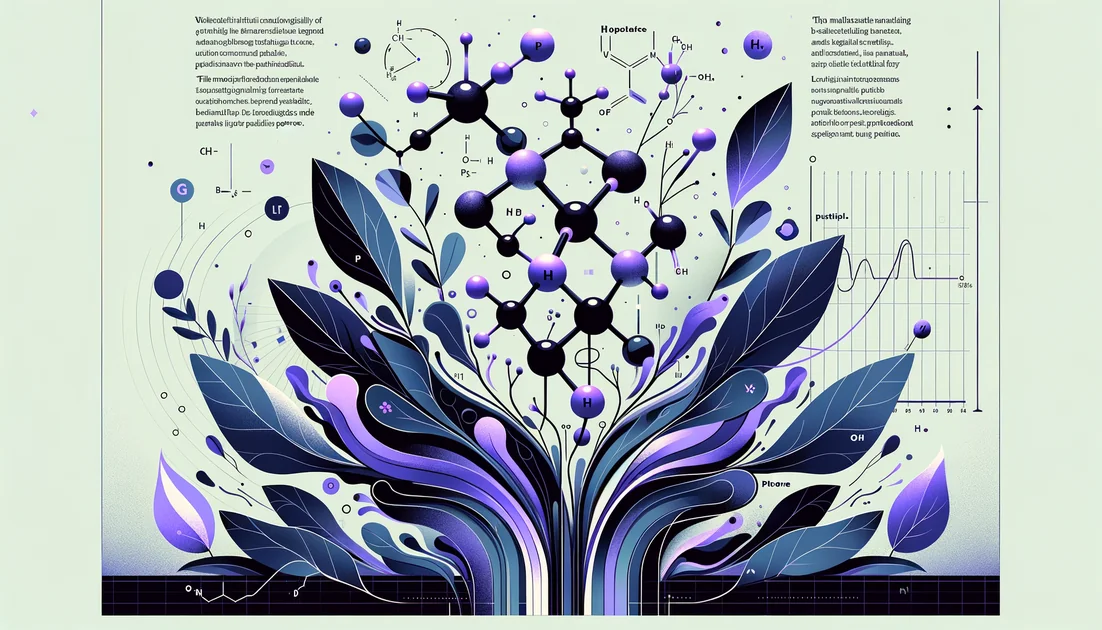
The Quiet Button: How GABA Went From Lab Curiosity to A New Kind of Calm
In 1950, a young biochemist named Eugene Roberts found an odd little molecule saturating the brain—GABA. At first, even giants of neuroscience doubted it was the language of inhibition. Decades later, you can buy it in gummies at the checkout line. Here's the paradox: the very messenger that tells brain cells to hush may not easily cross the brain's security gate. So why do some people feel calmer after swallowing it?[1][2][5]
- Evidence
- Emerging
- Immediate Effect
- Within 15–60 minutes (acute stress-recovery studies) → 2–8 weeks of daily use for BP/sleep-adjacent outcomes
- Wears Off
- Likely within days to weeks after stopping (based on food trials and autonomic markers)
The brain's quiet button
"GABA is the off switch of the brain," says neuropsychopharmacologist David Nutt—glutamate flips things on; GABA turns them down.[3] Roberts's 1950 discovery launched a scientific detective story: from crustacean stretch receptors to mammalian synapses, researchers traced an inhibitory current that helped stabilize the nervous system's storm of signals.[1][2] Yet the supplement story opens with a riddle. Reviews point out that oral GABA may not pass the blood–brain barricade efficiently. One mini-review put it plainly: evidence for benefits exists, but mechanisms remain uncertain, and some studies carry conflicts of interest. Any real effects might come from tiny amounts slipping through—or from signals traveling along the gut's own nervous system.[5] A 2020 systematic review concluded there's "limited evidence for stress and very limited evidence for sleep benefits of oral GABA intake."[4]
A bridge, a heartbeat, and a quick shift
Consider a small, vivid experiment from Japan. Volunteers with fear of heights crossed a suspended bridge—hands sweating, hearts racing. Those given GABA showed a steadier pattern: brainwaves tilted toward relaxed alpha within an hour, and stress-sensitive salivary IgA dipped less than in placebo.[6] It's a cinematic scene that hints at peripheral routes of action—calming the body's stress wiring first, with the mind following. A separate test used GABA-enriched chocolate (28 mg) before a timed arithmetic challenge. Fifteen minutes later, people who ate the chocolate recovered faster: their heart-rate variability—an index of resilience in the autonomic nervous system—normalized more quickly, and a stress marker in saliva didn't spike.[7] That's the kind of near-term effect a busy reader might actually notice: not knockout sedation, but less "echo" after a stressful hit.
From the gut upward
Here the plot thickens. GABA isn't just a brain chemical; it's also a microbial message. Several Lactobacillus and Bifidobacterium strains manufacture it; your intestinal neurons listen and relay along the vagus nerve, a hard-wired hotline to the brainstem.[14][15] Recent overviews even argue GABA could act like a postbiotic mediator—a compound made by microbes that nudges mood and stress responsiveness via gut–brain circuits.[14] In mice, a single oral GABA dose reduced short-term food intake only if timing matched a spike in vagal signaling—another clue that peripheral nerves, not brain entry, may be key.[16]
Blood pressure mornings and better nights
Japan embraced GABA as a food component long before wellness aisles did. In a randomized trial of a fermented milk naturally rich in GABA, mildly hypertensive adults saw meaningful systolic and diastolic drops within 2–4 weeks; the effect persisted through 12 weeks of daily intake.[9] A later trial of GABA-enriched rice found morning blood pressure readings improved over several weeks versus placebo rice—small numbers, but real-world food, real home measurements.[8] Sleep is trickier. The review evidence is mixed,[4] but a recent randomized, double-blind study in sedentary women with overweight used 200 mg/day of GABA for 90 days alongside exercise. Compared with placebo, the GABA group reported better sleep efficiency and lower negative affect; heart-rate variability suggested a shift toward parasympathetic (rest-and-digest) tone.[10] It reads like GABA smoothing the body's brake pedal more than sedating the mind.
The gym surprise
Then came an odd finding: 3 grams of GABA caused a sharp, transient rise in growth hormone at rest and amplified the post-exercise GH surge in resistance-trained men.[12] A small 12-week trial later paired 100 mg of GABA with whey protein, reporting greater gains in fat-free mass versus protein alone, along with higher resting GH at midpoints.[11] These are early signals, not guarantees of transformation—but they add a twist: GABA may influence recovery and composition via hormonal and autonomic routes, again without proving it floods the brain.
Outside the skull: immunity and inflammation
Immune cells carry GABA receptors. In animal models, oral GABA dampened inflammatory cascades without central side effects—precisely because it stays mostly outside the brain.[13] It's an unexpected angle: the same molecule that quiets neuronal chatter may cool the immune conversation in the periphery.
What this means for you
If you're chasing a calmer edge before a stress-heavy meeting or exam, the acute studies used modest amounts—often 25–100 mg taken 15–60 minutes beforehand—and looked for faster recovery, not knockout calm.[6][7]
For cardiometabolic or sleep-adjacent aims, daily low-to-moderate intake over weeks—as in fermented foods or 200 mg capsules—has shown small but measurable improvements in specific groups, especially when paired with lifestyle steps like exercise and regular bedtimes.[9][8][10]
If you experiment, treat GABA like a body-first signal: notice shifts in heart rhythm smoothness, muscle tension, or "after-stress echo," rather than expecting a sedative wallop. And if you use blood-pressure meds, monitor closely; GABA-fortified foods lowered BP in trials.[9]
The unresolved pieces
The mechanistic question remains open. As one review put it, we need tools like noninvasive magnetic resonance spectroscopy to test whether oral GABA nudges brain levels in humans—and better, independent trials to pin down who benefits and how.[5] Meanwhile, transporter biology offers another narrative thread. As transporters recapture GABA from synapses, drugs or nutrients that alter that clearance can prolong inhibition. "By inhibiting the GABA transporter, GABA is staying around for longer," neurochemist Baruch Kanner explained in a historical reflection—why clinically targeted GABAergic drugs can be powerful, but also carry side effects.[6][7][5]
"GABA is the off switch of the brain." —David Nutt[3]
"Limited evidence for stress and very limited evidence for sleep benefits of oral GABA intake." —Hepsomali et al., 2020[4]
Between those two statements lives today's truth: GABA undeniably runs the brain's brakes, but swallowing it seems to work best by talking to the body first—the gut, the heart, the vessels—then letting those signals rise.
Where the trail leads next
Expect studies that: (1) map gut-derived GABA to vagal firing and mood within hours, (2) compare fermented-food GABA with synthetic capsules head-to-head, and (3) test stacking with exercise, protein, or calming practices to see when small nudges add up. Roberts's "curious amino acid" has traveled from beef brains and crayfish nerves to bridge walks, chocolate squares, and gym floors. The mystery isn't solved—but the outline is clear enough to act with humility and curiosity.[1][2][14][15]
Key takeaways
- •GABA functions as the nervous system's primary "off switch," damping excitatory signals to stabilize brain activity.
- •Oral GABA may not cross the blood–brain barrier efficiently; benefits could stem from tiny amounts or peripheral/gut-brain signaling, so mechanisms remain uncertain.
- •Acute use: 25–100 mg taken 15–60 minutes before a stressor or bedtime has been studied for calmer autonomic recovery and settling pre-sleep arousal.
- •Ongoing use: 100–200 mg daily for several weeks appears in research on blood pressure and sleep quality (with exercise in one study).
- •Measured outcomes include faster autonomic recovery after mental stress, gentle reductions in mild hypertension over 12 weeks, and improved sleep efficiency and HRV over 90 days.
- •Cautions: may lower blood pressure and cause drowsiness; expect additive effects with other calming agents—dose and time accordingly.
You might also like
Explore more of our evidence-led investigations, comparisons, and guides across every article style.

Double Wood Supplements
The Paradox: A transparency-forward supplement brand with uneven third-party verification and compliance signals

Liposomal Vitamin C (liposome-encapsulated ascorbic acid) vs Standard Vitamin C (ascorbic acid; tablets/capsules)
For maximizing absorption per dose, choose liposomal vitamin C; RCTs show higher plasma and leukocyte exposure vs standard tablets at the same milligram dose. For value at routine intakes, standard vitamin C suffices—split doses if needed. [1][2][9]

Best for focus
L-theanine (100–200 mg) + caffeine (40–160 mg)

Beta-Alanine
You swallow the scoop and, within minutes, your skin prickles. The odd thing about beta-alanine is that you can feel it today—but its real work shows up weeks from now.


Tocotrienols
The stealthier cousins of vitamin E—built with springy tails that move differently in cell membranes and behave differently in your body.


